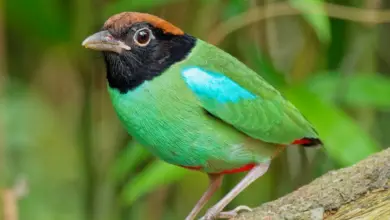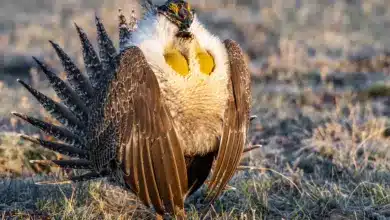The Townsend’s Warblers (Setophaga townsendi) are colorful, small songbirds that belong to the wood-warbler family.
Because of their bold yellow and black plumage details, they are one of the most distinctive of all the warbler species. Breeding males are most easily recognized by their yellow faces with black streaks and their black bibs that contrast greatly with their bright yellow upper chests.
They are part of the “virens” (green) Warbler group – together with the Black-throated Green, Black-Throated Grey, Golden-cheeked, and Hermit Warblers, all of which form a super-species. Members of this group have distinctive black throats and all, except for the Golden-cheeked Warbler – have greenbacks for which this group was named.
These migratory birds breed in the coniferous forests of western North America and most of them migrate south to Mexico or Central America for the winter.
Distribution / Habitat
These warblers breed from southern Alaska and northwestern Canada – south from the Yukon Territory, east to southern Alberta – south into the USA to Oregon and Idaho.
After the breeding season (typically in or around September), northern birds will migrate south to spend the winter in coastal southwestern California, northwestern Baja California, and northern Mexico south to Nicaragua. Small numbers of them overwinter south to Panama.
Resident (non-migratory) populations exist in the highlands of Mexico and Central America.
These birds prefer dense, coniferous, and mixed coniferous-deciduous forests, but may also be found in chaparral, suburban gardens, and parks.
Dynamic map of eBird sightings (View sightings and enter your own)
Description
Size
Length (including tail): 4.3 – 5 inches (11 – 13 cm)
Plumage Details / Adults
Breeding Males:
- black cap, nape, ear patches, throat and bib
- yellow face with black stripe across their cheeks and yellow crescent under the eyes
- bright yellow chest
- olive green back
- bold black streaks on the sides and flanks
- white abdomen
- dusky tail
- black wings except for two white wing bars and white outer tail feathers
Non-breeding Males:
- black bib is replaced by dark streaking
- rest of the plumage turns dusky olive.
Females
- olive-green, dark cap with thin black streaks
- yellow throat with some black markings
- olive cheek patch
- yellow cheeks, throats, chests, and sides
- white abdomen and under tail feathers
- two white wing bars
Other Physical Details
- thin pointed bill
Juvenile Description
Juveniles resemble the females of this species, except they have dark green caps and cheeks; they lack the blackish markings on the throat and have indistinct streaking on their backs.
Similar Species
The Townsend’s Warblers can most easily be confused with the Black-throated Green Warblers, the Hermit Warblers, and the Golden-cheeked Warblers – all of which are believed to have evolved from the same ancestral stock.
Females and juvenile birds look quite alike, and identification is mostly done by comparing the breeding males of these species.
- The Hermit Warblers are their closest relatives and along the Oregon-Washington border, these two species are known to interbreed (hence this area is also referred to as a “hybrid zone”). The Hermit Warbler lacks the black face masks of its relative. It has yellow eyerings, a yellow forehead, and a white chest. Hybrids of these two species possess characteristics of both species.
- The Black-throated Green Warbler, found in the eastern part of the continent (east of the Rocky Mountains), can be identified by the yellow markings at the vent under the tail; the unmarked, greener back; and the less well-defined cheek patches
- The Golden-cheeked Warbler has a yellow face with a distinct dark line through each eye. It has less yellow on the chest.
Diet / Feeding
On their breeding grounds, these warblers mostly feed on insects, such as caterpillars, beetles, leafhoppers, and spiders; and seeds.
Within their wintering range in Mexico and Central America, the greater part of their diet consists of berries and honeydew nectar excreted by sap-sucking scale insects.
Insects are either caught in flight or gleaned from foliage high in the forest canopy. To a lesser extent, they may forage low in bushes and shrubs or may pursue prey on the ground – particularly in places where there are patches of their favorite honeydew-producing insects.
They will also visit bird feeders in urban gardens for seeds and suet. They particularly like peanut butter.
In winter, they are often seen foraging in flocks. During the breeding season, they are mostly seen alone, in pairs, or in small family flocks.
These birds defend their favorite territories against other Townsend’s Warblers as well as other bird species.
Breeding / Nesting
Townsend’s Warblers typically breed in denser forests of grand fir, Douglas fir, and Engelmann spruce. In the Pacific Northwest, they nest in montane spruce-fir (Picea-Abies) forests; and in Alaska and the Yukon Territory in Canada, their breeding grounds are boreal forests.
Their shallow cup nests are constructed out of small twigs, dried grasses, grass stems, cedar bark, pine needles, lichens, and spider cocoons; and they are lined with fine grasses, moss, feather down, or hair.
These nests are often found on the end of high branches of coniferous trees in areas where they are well concealed by foliage. On occasion, females were observed partially constructing nests at one location and then moving the material to other trees to finish their nests there.
A clutch may consist of 3 up to 7 eggs, but mostly the average nest has 4 – 5 eggs. The eggs are whitish with brown speckles. The incubation period is believed to be about 12 days.
The helpless hatchlings only have tufts of down and require parental care for survival. Both parents feed and protect them. The young fledge when they are about 10 days old.
Calls / Vocalizations / Sounds / Recordings
Calls: a sharp tups or a soft chip.
Songs: Variations include: buzzed weazy weazy weazy dzeee … zi-zi-zi-zi-zi-zi, zwee, zwee … zee-zee-zee-bzz-zee … weazy weazy weazy weazy twea or dee dee dee-de de
https://www.xeno-canto.org/embed.php?XC=156550&simple=1
Alternate (Global) Names
Chinese: ???? … Czech: Lesnácek Townsenduv, les?á?ek západní … Danish: Sortøret Sanger … Dutch: Townsends Zanger … Estonian: nulusäälik … Finnish: Kuusikerttuli … French: Fauvette / Paruline de Townsend … German: Townsend Waldsänger … Italian: Dendroica di Townsend, Parula di Townsend … Japanese: taunsendoamerikamushikui … Norwegian: Granparula … Polish: lasówka czarnolica … Russian: ???????? ?????? ????? … Slovak: horárik ?e?inový … Spanish: Chipe de Townsend, Chipe negriamarillo, Chipe Negroamarillo, Chipe Negro-Amarillo, Reinita Bicolor, Reinita de Townsend … Swedish: Townsends skogssångare





